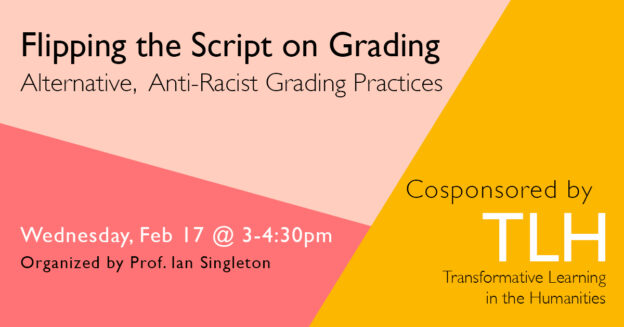This blog post is by Contributing Author Ian Singleton. Ian Singleton is an Adjunct Writing Instructor and a recipient of a Transformative Learning in the Humanities award for organizing an event in our Spring 2021 series on active and participatory learning.
Contract grading is an alternative assessment practice that can aid anti-racist pedagogy. Another practice is “A for All,” which effectively refutes any kind of assessment system whatsoever. What do students, specifically CUNY students want? I sought to organize a space and time for students to feel free to answer the question, “How do you want to be graded?” The question could be, “How do you want to be assessed?” or “How do you want to be judged?”
The forum I organized, Flipping the Script on Grading: Alternative, Anti-Racist Grading Practices, took place on February 17. There were 42 people in the Zoom session at its peak. 32 people responded to the questionnaire with which I began the forum. 20 of those respondents were students, 4 were faculty, 4 staff, and 4 were “none of the above.”
The first to speak was a faculty member who, having attended a New England private school, said his background in education was simply not applicable to the experiences of the diverse student body he taught. In short, experience is a major part of what happens in the classroom. It’s impossible that the experience of the professor and of each of the students won’t affect grading and grades.
Of those students who responded to the questionnaire, we heard from a Muslim student who described how empowering it was to have a professor listen to her, especially during this year in which she described how difficult it has been for professors to find ways to assess students. This student mentioned that many of her peers have dropped out.
Another student also described how important a discussion of the financial situations of students was. She described how important it was that she, a student with an unstable financial situation, have some say in how she would be assessed during this time.
A representative of a CUNY program to help court-involved and formerly incarcerated students expressed some hesitation about removing grades altogether, such as with the “A for All” approach. For some students, receiving an A, perhaps for the first time, an A they earned, is incredibly empowering.
An educator from North Dakota mentioned having gone through a “conversion” to Peter Elbow’s contract grading practice. She mentioned that earlier she had perhaps used racist assessment practices, that she would assess a student on whether they wrote “white.”
According to an educator from Maryland, ungrading, as discussed in Ungrading, ed. by Susan Bloom, is catching on in K-12.
A student mentioned enjoying how creative contract grading can make the classroom. She mentioned being able to write something creative and how, when that was accepted as legitimate writing by the professor, she became much more engaged in writing.
A faculty member mentioned how she has a learning disability and how she struggled even to complete college. Some students, who are used to receiving As, don’t strive and end up doing less than they could because they only work enough for the A.
Again, there was some pushback on these alternative practices. But I think that the contract also challenges these students. It gives them a chance to say, “Here’s the bare minimum I can do to pass this class.” There’s nothing wrong with that. But if they move beyond that bare minimum, as they’ve defined it along with their own expectations, they can have a grade that, yes, is simply a letter, but a representation of their work, something they defined and established in their contract, something they have documented there, and something that truly represents their labor in higher education.
Ian Singleton is an Adjunct Writing Instructor and a recipient of a Transformative Learning in the Humanities award for organizing an event in our Spring 2021 series on active and participatory learning.


